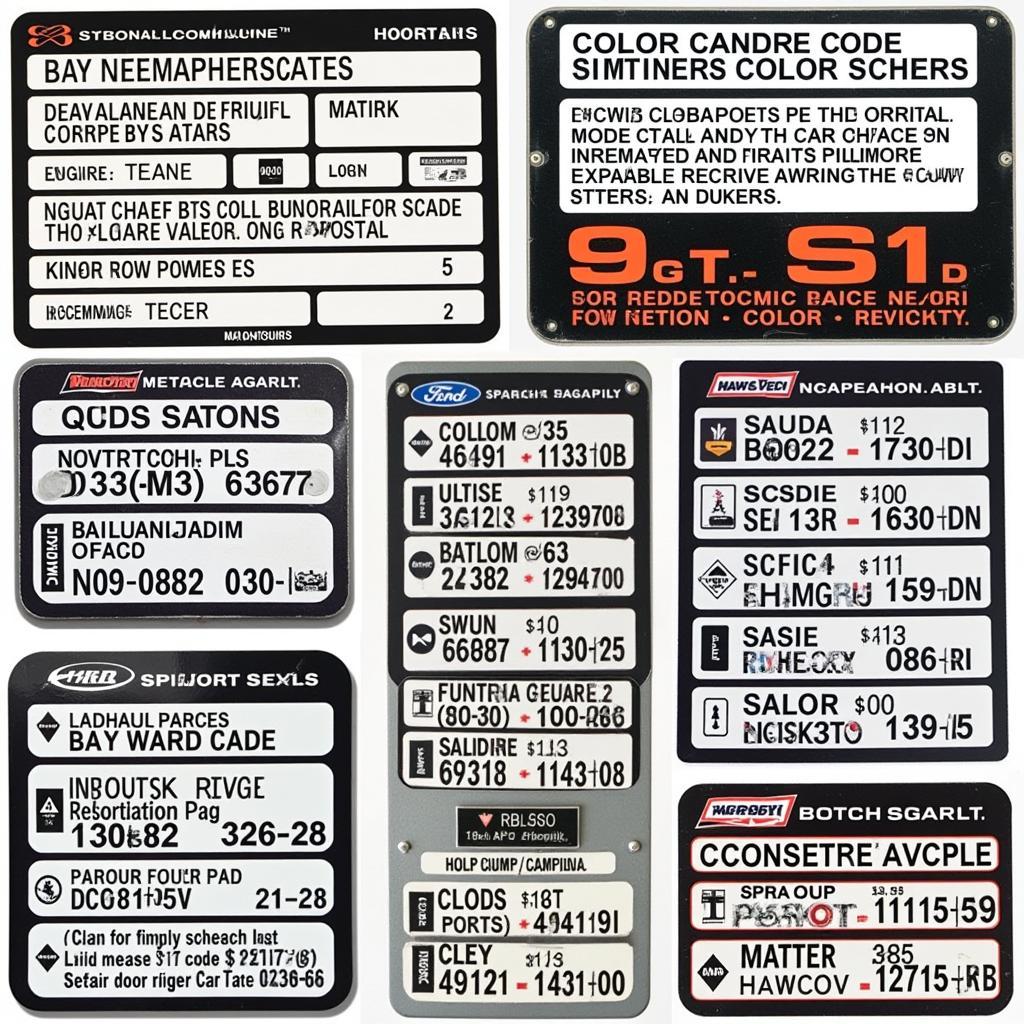Finding your car’s color code is crucial for touch-ups, repairs, or even a full repaint. Whether you’re dealing with a scratch, a dent, or simply want to ensure a perfect color match for accessories, knowing this code can save you time, money, and frustration. This guide provides comprehensive information on how to check the color code of your car, covering various locations and methods to ensure you find the information you need.
Knowing how to locate your car’s color code simplifies the process of getting an exact match for your car’s paint. It saves you the hassle of dealing with mismatched paints and ensures a seamless repair or touch-up. Have you ever wondered what color best suits a black tie optional event? Find out more about suit colors for black tie optional events.
The color code is usually a combination of letters and numbers that specifically identifies the exact shade and formula used for your car’s paint. It’s like a fingerprint for your car’s color, ensuring that any touch-up or repaint blends seamlessly with the original finish. Locating this code might seem daunting, but with a little guidance, it’s easier than you think. This detailed guide will equip you with all the necessary information to locate this essential code.
Where to Find Your Car’s Color Code
The location of your car’s color code varies depending on the make and model. Common places include the driver’s side doorjamb, the glove compartment, the vehicle identification number (VIN) sticker, under the hood, or even in the owner’s manual. Sometimes, the color code is printed directly on a sticker, while in other cases, it might be part of a longer code string.
Checking the Driver’s Side Doorjamb
The driver’s side doorjamb is the most common location for the color code sticker. Open the driver’s door and look along the frame for a sticker or a metal plate. The color code is often labeled with “C/TR,” “PAINT,” “COLOR,” or similar abbreviations.
Inside the Glove Compartment
Some manufacturers place the color code sticker inside the glove compartment. Check the inside walls, the lid, or even the glove compartment door for the sticker. The information may be printed directly on a sticker or included within the owner’s manual stored in the glove box.
The VIN Sticker
The vehicle identification number (VIN) sticker often contains the color code. This sticker is usually located on the driver’s side dashboard, visible through the windshield. It can also be found on the driver’s side doorjamb or other locations specified in your owner’s manual.
Under the Hood
In some cases, the color code sticker might be found under the hood, usually on the radiator support, the strut tower, or near the firewall. If you’re exploring various color options, you might also be interested in what your color says about you. Find out more about what is your color.
Owner’s Manual
Your car’s owner’s manual should contain information about the color code. Look in the index or the sections related to maintenance and paint for details. Even if the code itself isn’t listed, the manual might direct you to the location of the sticker. Knowing how to change canvas sidebar color can be a great way to personalize your digital workspace. Explore options for canvas sidebar color customization.
 Car Color Code Sticker Examples
Car Color Code Sticker Examples
Using Online Resources to Find Your Car’s Color Code
Several online resources can help you find your car’s color code using your VIN. Websites specializing in automotive information often have databases that link VINs to color codes. Automotive forums can also be valuable resources, with members sharing their experiences and knowledge.
What if I Can’t Find the Code?
If you’ve exhausted all the above methods and still can’t find the color code, contact your car’s manufacturer or a dealership. They should be able to provide the information based on your VIN.
Why is Knowing Your Car’s Color Code Important?
Knowing your car’s color code is essential for accurate color matching during repairs. This ensures a seamless blend between the repaired area and the original paint, maintaining your car’s aesthetic appeal. Are you considering LED headlight upgrades? Check the legality of LED headlights in Colorado. You can also learn more about what color tube is used for a BNP test.
Conclusion
Knowing how to check the color code of your car is a valuable skill for any car owner. Whether you’re dealing with a small scratch or a major repair, having the correct color code will ensure a perfect match and maintain your car’s value.
FAQ
-
What does a car color code look like? It’s typically a combination of letters and numbers.
-
Is the color code the same as the paint code? Yes, they are generally used interchangeably.
-
Can I find my car’s color code online? Yes, several online resources can help you find it using your VIN.
-
What if my car’s color code sticker is damaged? Contact your manufacturer or a dealership.
-
Why is it important to have the correct color code? It ensures a perfect match for touch-ups and repairs.
-
Where else might I find the color code besides the common locations? Some manufacturers place it under the hood or on the rear quarter panel.
-
Can a body shop match the color without the code? Yes, but having the code ensures the most accurate match.
Common Scenarios
-
Scenario 1: Minor scratch on the bumper – Knowing the color code allows for easy touch-up without noticeable differences.
-
Scenario 2: Replacing a damaged fender – The body shop will need the color code to repaint the new fender and ensure a perfect match with the rest of the car.
-
Scenario 3: Customizing your car with accessories – The color code helps you choose accessories that perfectly complement your car’s color.
Further Reading
For more information on car maintenance and related topics, you can explore our other articles: Are LED headlights legal in Colorado?
Call to Action
Need assistance finding your car’s color code or have other car-related questions? Contact us at Phone Number: 0373298888, Email: [email protected] or visit our address: 86 Cầu Giấy, Hà Nội. We have a 24/7 customer service team ready to help.

